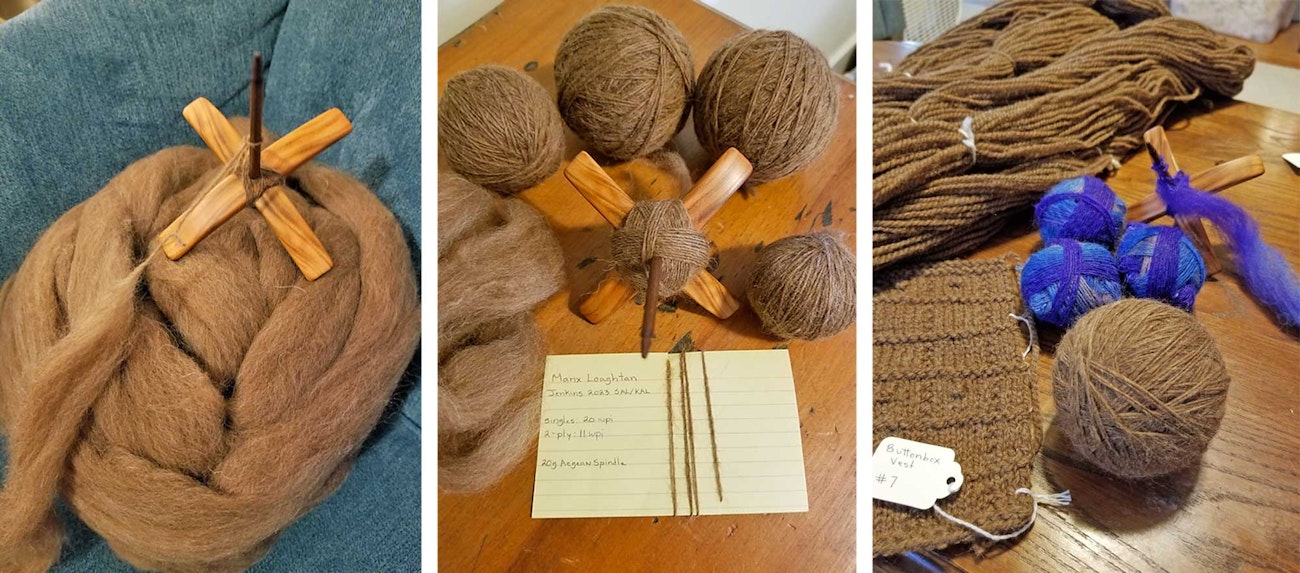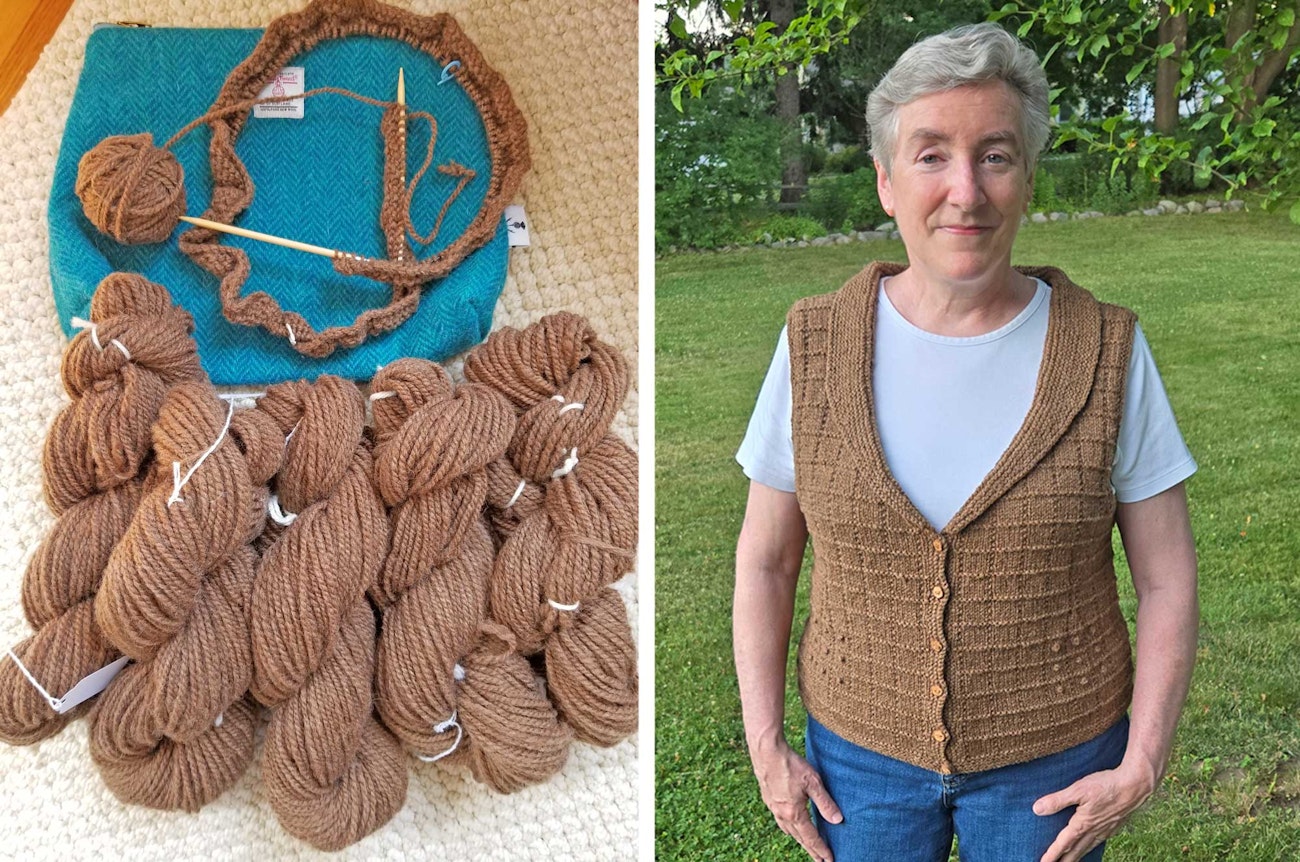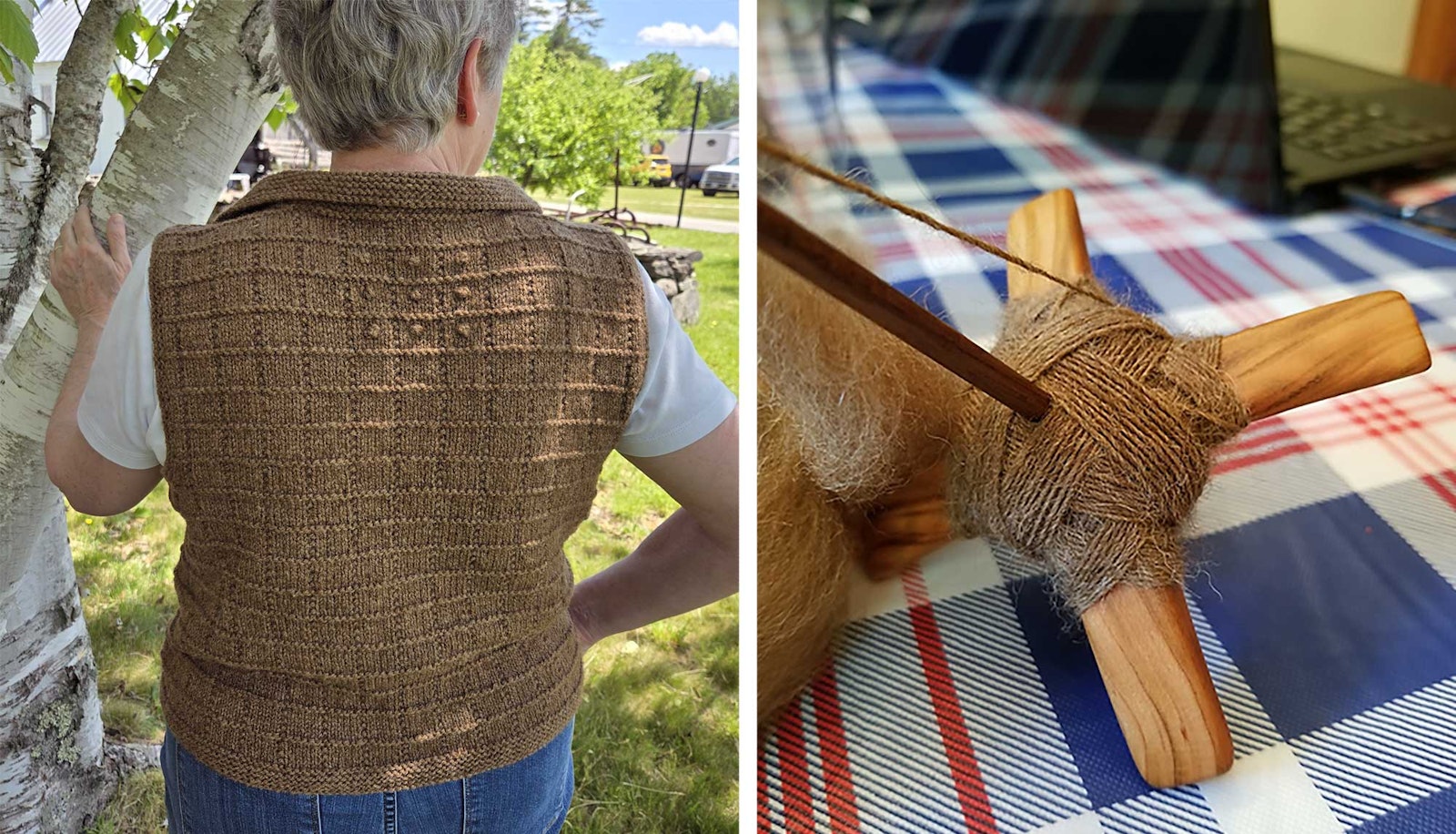Pattern and designer Buttonbox by Elizabeth McCarten.
Fiber/preparation Manx Loaghtan commercial top.
Wheel system/spindle 20 g Jenkins Aegean cross-arm spindle.
Drafting method Short downward draw.
Singles direction Z-twist.
Singles wraps per inch 20.
Ply wraps per inch 11.
Total yardage 780 yd.
Yards per pound 925.
Yarn classification/weight Worsted.
Yardage used 750 yd (685 m), 12.6 ounces (353 g).
Gauge 19 sts = 4" (10 cm).
Needles Size 6 (4 mm).
Finished size 43".
The Challenge
This vest was completed as part of a year-long spin-along that the Jenkins Spindle community held in its Ravelry group. The challenge was to spin a pound of fiber (about 450 grams) and create one or more wearable projects within a year. I chose a commercial top to avoid fiber prep, and for interest, an unusual breed with a beautiful natural color, the Manx Loaghtan. The mouse-brown color of this rare breed from the Isle of Man seemed like a fiber I could spend a lot of time with.
Manx Loaghtan is a medium wool with the softness of Shetland and the bounce and bulk of a down breed. To spin this open and airy top, I used a short downward draw using a pinch-and-release technique. The Manx didn’t lock up and was quite easy to draft and spin.
I found that I could comfortably spin about 15 grams of fiber on the spindle before it got too heavy, but this is only about 50–60 yards (about 45–55 m) of yarn. To avoid short skeins, I joined two cops together by spinning the end of the first cop onto the end of the cop that was still on the spindle. These two joined cops were wound together into a ball. Two balls of singles were then wound together onto a felt core to create a ply ball of about 120 yards (about 110 meters).
 Shown left to right: Manx top and cross-arm spindle; fiber is shown with a ball of singles and ply balls; swatch, finished yarn, ply ball, and a blue spin for a change of pace.
Shown left to right: Manx top and cross-arm spindle; fiber is shown with a ball of singles and ply balls; swatch, finished yarn, ply ball, and a blue spin for a change of pace.
I always use a top-whorl spindle to ply. I find winding on to be fast and efficient, and it’s straightforward to wind off onto a niddy noddy. As soon as I have a ply ball ready, I ply it. It’s a welcome change after spinning, and it’s fun and motivating to finish a skein. Skeins were washed in a gentle wool wash and hung, unweighted, to dry. The yarn poofed up into a springy, worsted weight yarn at 11 wraps per inch.
The Long Haul
This was a large project and the biggest challenge was staying motivated. Probably the three things I did to keep the project from stalling were to ply and finish skeins along the way, take breaks with other small projects, and participate with a community in the spin-along. The Jenkins group is a large and active group filled with talented spinners who create incredible finished projects with their small spindles. Monthly check-ins with progress photos were required to keep everyone on task. Pictures of completed projects, from small accessories to entire sweaters, served as further inspiration to keep going.
To maintain consistency over the eight months it took to complete the vest, I frequently compared my spun singles to a yarn gauge, maintaining about 20 wraps per inch. I also kept a sample of the singles on an index card and referred to it as well. I find that one of the great advantages of spindle spinning is the opportunity to compare the recently spun singles when winding on. Most spindle spinners take great care to wind on neatly and build beautiful cops. Laying the yarn in a neat progression allows the spinner to constantly compare the latest make with what has already been wound on.
 Left: Finished yarn and the vest in progress. Right: The author models her finished vest; photo by James Driscoll.
Left: Finished yarn and the vest in progress. Right: The author models her finished vest; photo by James Driscoll.
I found Elizabeth McCarten’s Buttonbox Vest a good match for my Manx yarn. The little garter-stitch boxes and sweet bobble detail looked great in my swatch and the fabric felt squishy, firm, and showed great stitch definition. The finished vest holds its shape and the even, brown color enhances the windowpane pattern. My favorite part of this project was knitting the vest and watching it take shape. I never tire of knitting with my handspun; it feels like magic to knit a wearable garment from yarn that started out as a bag of fluff.
I started spinning 36 years ago after watching a spinning demonstration. I was hooked on spinning and raised Angora rabbits for a number of years. I have done many public demonstrations at fairs and historic sites and love showing people how yarn is spun.
Join us as we celebrate the beloved and ever-useful spindle in its many forms—suspended, supported, grasped, driven, and beyond—in the Fall 2024 issue of Spin Off.
Martha Driscoll is a systems manager for a library network in Massachusetts. She has been spinning and knitting for over 35 years. Four years ago she began spinning almost exclusively on spindles and loves top-whorl and cross-arm spindles the best.

